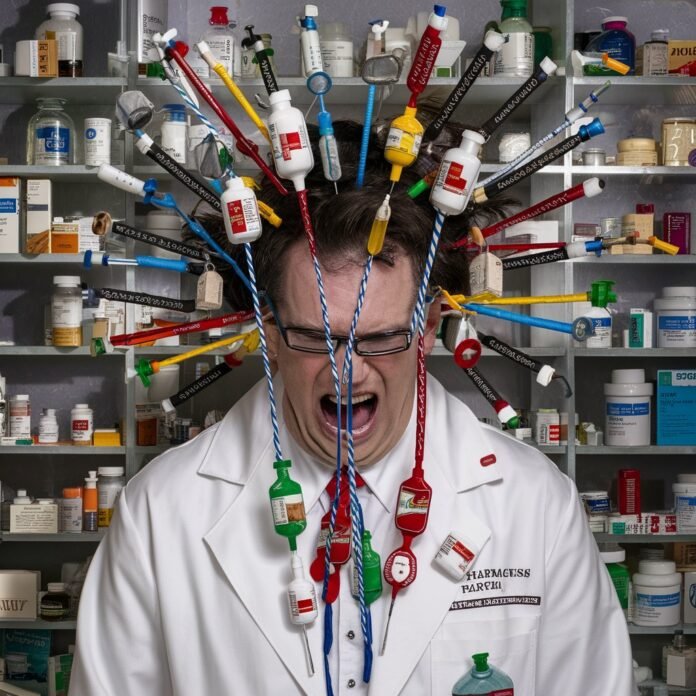Introduction
The viral video of a CVS pharmacist’s emotional meltdown during a hectic shift has sparked nationwide discussions about pharmacy workplace conditions – with an unexpected twist involving bolo ties. This peculiar combination of pharmaceutical stress and Western accessories reveals deeper truths about healthcare worker burnout, personal coping mechanisms, and even uniform policies in corporate pharmacies. At the intersection of mental health advocacy and fashion statements, we examine how this unusual pairing became a symbol for systemic issues in American pharmacies, while exploring why bolo ties might represent more than just a style choice for overworked medical professionals.
1. The CVS Meltdown Heard ‘Round the Pharmacy World
The now-infamous footage capturing a CVS pharmacist breaking down under pressure didn’t just go viral for its raw emotion – it became a lightning rod for industry-wide frustrations. Pharmacy staff across the nation recognized the perfect storm of understaffing, unrealistic corporate metrics, and patient demands that led to this boiling point. What began as another stressful shift became a watershed moment, with thousands of healthcare workers sharing their own “near-meltdown” experiences in solidarity. The incident has prompted CVS corporate to review working conditions, but many argue true change requires more than policy adjustments – it demands a complete overhaul of how we value pharmaceutical care professionals in the retail healthcare ecosystem.
2. Bolo Ties: The Unexpected Symbol of Pharmacy Rebellion
Amidst the emotional outburst, viewers couldn’t help but notice the pharmacist’s distinctive bolo tie – a sartorial choice that seemed at odds with corporate pharmacy aesthetics. This Western accessory, typically associated with rodeos and country music stars, has quietly become a subtle form of self-expression for medical professionals chafing against clinical uniformity. Some pharmacists report adopting bolo ties as a way to maintain individuality in sterile environments, while others see it as a nod to the profession’s historical roots when local apothecaries often served as community gathering places with distinctive personalities. The bolo tie in this context transforms from mere neckwear to a quiet statement of professional identity.
3. Corporate Uniform Policies vs. Healthcare Worker Morale
The visibility of the bolo tie during this viral incident has reignited debates about medical workplace dress codes. While chains like CVS enforce standardized uniforms for brand consistency, many healthcare professionals argue that limited personal expression contributes to workplace dissatisfaction. Psychological studies suggest that allowing even small forms of self-expression, like distinctive accessories, can improve job satisfaction in high-stress environments. Some progressive pharmacies are now experimenting with “professional but personalized” dress codes that balance corporate image with employee morale – though traditional chains remain resistant to changes that might dilute their carefully cultivated brand identities.
4. Systemic Stress in Retail Pharmacy: Beyond the Breaking Point
The CVS incident didn’t occur in isolation – it reflects an industry pushed to its limits. Pharmacists today face unprecedented pressures: filling hundreds of prescriptions daily while administering vaccines, managing insurance complexities, and serving as de facto primary care providers for many patients. The average retail pharmacist makes critical medical decisions every 3-4 minutes for 12-hour shifts without adequate breaks. This unsustainable pace, combined with corporate profit pressures and patient frustrations, creates a pressure cooker environment where meltdowns become inevitable rather than exceptional. Healthcare advocates are using this moment to push for mandated pharmacist-to-patient ratios and federal legislation protecting pharmacy workers’ rights.
5. When Personal Style Becomes Professional Armor
The bolo tie in the viral video represents more than a fashion choice – it’s part of a growing movement where healthcare professionals use personal style as psychological armor against workplace stress. From colorful compression socks to novelty badge reels, medical workers are finding small ways to reclaim individuality in systems that often treat them as interchangeable parts. Psychologists note these personal touches serve as important reminders of identity beyond job titles, helping prevent the depersonalization that contributes to burnout. The bolo tie specifically, with its Western connotations of independence and frontier spirit, may represent a particularly poignant symbol for professionals feeling trapped in corporate healthcare structures.
6. The Road to Pharmacy Workplace Reform
In the wake of this incident, pharmacy associations are mobilizing to address systemic issues. Proposed solutions include: implementing mandatory mental health days, capping daily prescription volumes, increasing technician staffing ratios, and creating protected break periods. Some pharmacists are organizing unions, while others advocate for specialized mental health resources tailored to medication professionals. The bolo tie has unexpectedly become a mascot for this reform movement, appearing at rallies and in social media campaigns as a symbol of professional pride and the right to individuality within healthcare systems.
Conclusion: More Than a Meltdown – A Movement
What began as another stressful day behind the pharmacy counter has blossomed into a national conversation about healthcare worker treatment, corporate responsibility, and the surprising power of personal style in professional settings. The CVS pharmacist’s bolo tie may be remembered as the unlikely emblem of a turning point for pharmacy workers’ rights. As the industry reckons with these issues, one truth becomes clear: the solution isn’t just about preventing meltdowns, but about creating systems where healthcare professionals can thrive – whether they prefer bolo ties, bow ties, or standard-issued scrubs.



